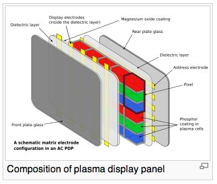PLASMA DISPLAY TECHNOLOGY or PDPs
“In 1964, researchers at the University of Illinois developed the first ac-driven memory display that they called the ‘plasma display panel’. As an emissive display technology, PDPs possess many of the advantages of the CRT, such as wide viewing angle and excellent color. Furthermore, PDPs are true flat panels, so they do not suffer from the bulkiness of projection or CRT systems.” [18]
This gas-discharge display demonstrates an image when a sealed glass envelope is placed in contact to a high-voltage electric field that creates the ionization of the gas, better known as plasma. The glass is a hermetically sealed envelope with an inert gas mixture: helium, neon, argon, and xenon.[18]
While LCDs occupy the majority of the market for general and personal electronics, Plasma displays have provided visual performance similar to their predecessor the CRT.
 LCD’s and Plasma screens provide the advantage of a relatively low cost and high performance display. Although they are a great viewing resource on the personal usage level, LCD’s and Plasmas may be a rigid and inconvenient alternative when scaling to the size of a Panorama level. Currently Video Projectors otherwise known as Digital Projectors provide a lower cost and flexible solution for larger scale demonstrations
LCD’s and Plasma screens provide the advantage of a relatively low cost and high performance display. Although they are a great viewing resource on the personal usage level, LCD’s and Plasmas may be a rigid and inconvenient alternative when scaling to the size of a Panorama level. Currently Video Projectors otherwise known as Digital Projectors provide a lower cost and flexible solution for larger scale demonstrations
lllllllllllllllllllllllllllllllllllllllllllllllllllllllllllllllllllllllllllllllllllllllllllllllllllllll
lllllllllllllllllllllllllllllllllllllllllllllllllllllllllllllllllllllllllllllllllllllllllllllllllllllll
